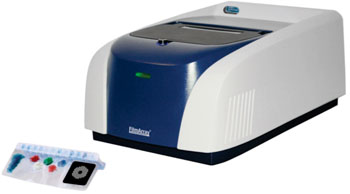Rapid Methods Compared for Positive Blood Cultures
By LabMedica International staff writers
Posted on 20 May 2014
The need for rapid antibiotic treatment of sepsis is well recognized, and the time to implementation of appropriate antibiotic therapy is critical in improving the outcome of sepsis.Posted on 20 May 2014
Several methods have been developed to identify pathogens and some antibiotic resistance genes directly from positive blood culture bottles, which can shorten the time for final identification and susceptibility by as much as one to two days.

Image: FilmArray Direct from Positive Blood Culture Identification system (BCID) (Photo courtesy of BioFire Diagnostics).
Medical laboratory scientists at the University of Florida (Gainesville, FL, USA) directly compared a multiplex polymerase chain reaction (PCR) method with a mass spectrometry system to identify organisms in positive blood cultures, between October 2012 and May 2013. They analyzed fluid from 161 positive blood cultures by both methods within 2 to 12 hours of the time the culture signaled positive in BacTec plus aerobic/F bottles incubated in a BacTec 9240 instrument (Becton, Dickinson and Company; Franklin Lakes, NJ, USA).
The two methods used to identify the bacteria were the FilmArray Direct from Positive Blood Culture system (BCID) (BioFire Diagnostics, Salt Lake City, UT, USA) and the VITEK Mass Spectrometry System (Vitek MS, bioMérieux; Durham, NC, USA). The BCID uses multiplex PCR to identify 90% to 95% of common isolates to the genus or species/complex level as well as three antibiotic resistance genes in approximately one hour. The prepared slides for the Vitek MS system were run in a bioMérieux mass spectrometer (Marcy l’Etoile, France).
A total of 132/133 (99%) of isolates that were in the FilmArray panel were identified correctly to the genus and/or species level. For those organisms that the FilmArray could identify to the species or species/complex level, 84/84 (100%) were correctly identified; for those that would only be expected to be identified to the genus level, 48/49 (98%) were identified correctly. The turnaround time for an individual FilmArray test is about an hour and if multiple samples need to be run, multiple instruments may be necessary.
Mass spectrometry correctly identified 142/151 (94%) monomicrobic cultures to the genus level and 137/151 (91%) to the species level. Vitek MS can process up to 48 specimens per slide in approximately an hour, but the actual time to perform a direct identification from a positive blood culture bottle would depend both on the filtration time and the workflow in the clinical microbiology setting to set up the slide and be read in the mass spectrometer.
The authors concluded that both the FilmArray and the VITEK MS mass spectrometry systems were highly accurate and can provide results in about an hour after blood cultures become positive, but the FilmArray is far easier to perform and to incorporate into laboratory workflow. The study was published online on March 22, 2014, in the journal Diagnostic Microbiology and Infectious Disease.
Related Links:
University of Florida
Becton, Dickinson and Company
BioFire Diagnostics














